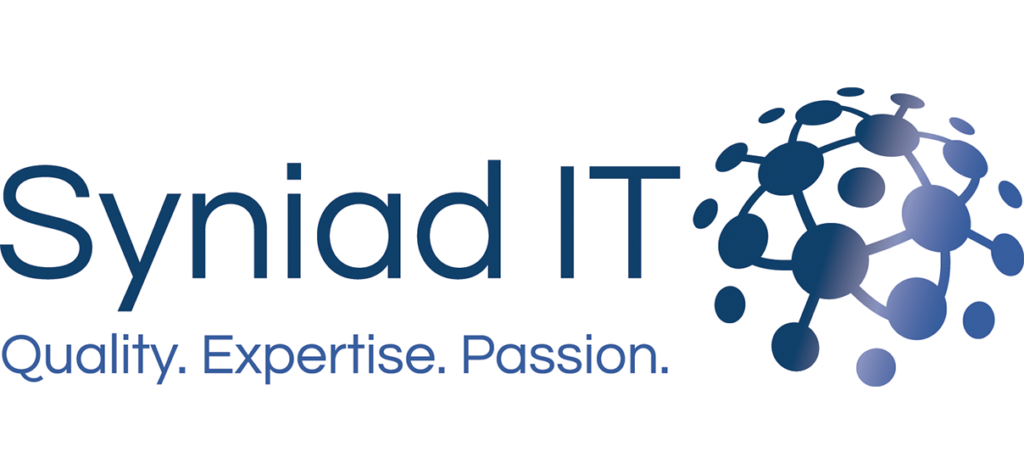Great sponsors make great events.
We are delighted to welcome Syniad IT as one of our Service North Sponsors in 2021 – their fourth time at our event. And in this occasion we would like to say a huge thanks to Syniad IT for being with us from the start. We’re grateful for your support.
In this blog, the Director of Syniad IT, Steve Morgan talks about the challenges related to tooling and automation in a SIAM ecosystem.
About Syniad IT
My name is Steve Morgan and I’m the Director of Syniad IT. We specialise in the assessment, design, build and improvement of IT Operating Models, particularly those which involve multi-supplier integration (MSI). We’ve been heavily involved in the development of best practices in this area, most notably as contributing authors to the Service Integration & Management (SIAM) Foundation and Professional Body Of Knowledge publications.
Syniad IT helps organisations across industry sectors and geographies. We find that regardless of the specific industry challenges the principles embodied in ITIL, SIAM, VeriSM and other leading best practices apply equally, regardless of sector, size, location or scale of change.
When is SIAM appropriate?
My view on SIAM is that it is an important framework when working with IT Operating Model changes which involve multiple suppliers. Most organisations today have some form of supplier dependencies, whether it’s a for a small maintenance agreement or a major IT outsource. As more and more organisations look to disaggregate their monolithic IT sourcing contracts, there is more of a dependence to design, build and implement IT Operating Models which are capable of managing this increased complexity.
But SIAM need not be the only tool in the toolbox. SIAM principles work alongside any of the leading best practices, particularly things like ITIL.
What is a Service Integrator?
One of the key elements in SIAM is the role of the Service Integrator. This function is critical in SIAM, it is the glue which joins together all of the various parts of the SIAM Operating Model. The Service Integrator role can either be done by customer staff, an in-house approach, or outsourced, either exclusively or as part of another outsource contract.
Each of these options has their own benefits and drawbacks, and the approach chosen will be dependent of the particular circumstances of a customer and the challenges they are trying to resolve.
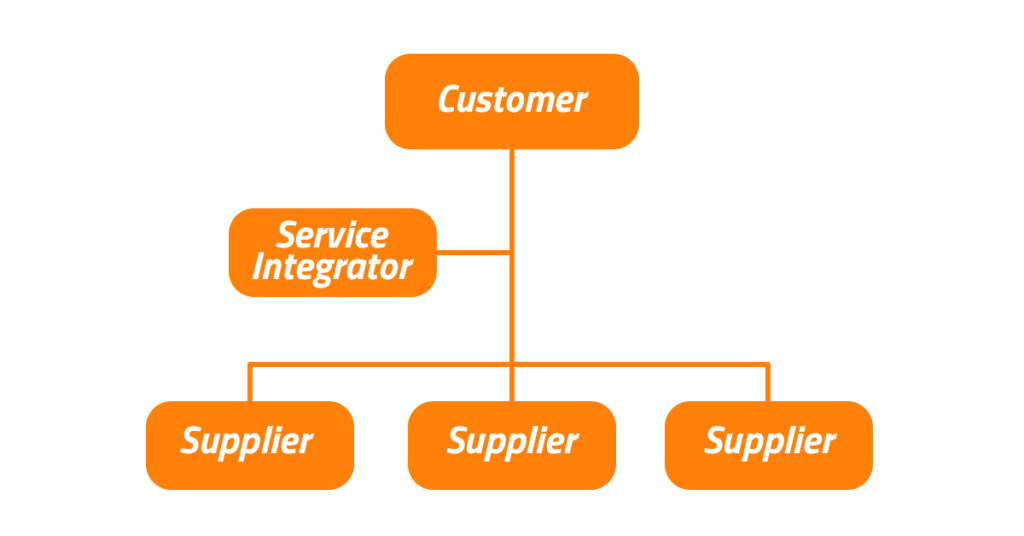
So, SIAM is just multi-supplier ITSM?
No! Often, when we think of SIAM, we tend to focus on the day-to-day management of “tickets”; Incident, Problem, Change, Configuration and Release Management. It’s true, one of the key areas where SIAM brings benefits is in these core Service Management processes. However, when an organisation moves to a SIAM model, the impact is way beyond these traditional Service Management processes.
The whole IT organisation is impacted by the change to a SIAM model. This includes everything from idea generation, demand management, design, build, test, run. It also includes all of the management practices involved in running an IT department, including cost management, accounting, supplier management and IT architecture.
To embrace a SIAM model and ignore the whole IT service lifecycle and all the practices which support it, is a huge mistake. As a minimum, an impact assessment on the whole operating model should be undertaken, to ensure that changes to working practices are understood.
So, SIAM is just about processes?
To think about SIAM as just about process is a mistake. As with any IT operating model, process is only part of the picture. Equally, we must also consider the following areas:
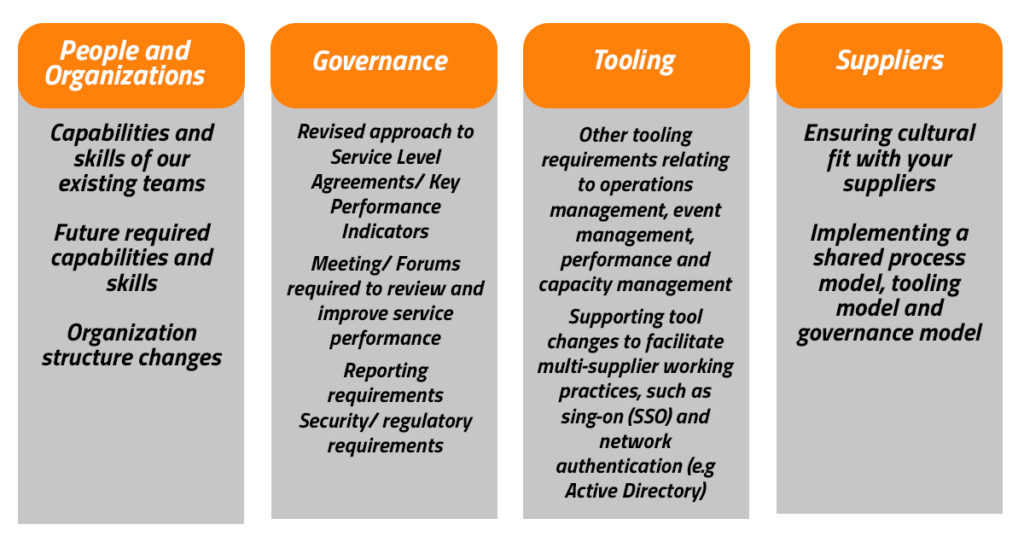
Structuring a SIAM programme
Whatever framework you choose to move to a multi-supplier operating model, you will need to establish a change programme to make it happen.
This programme should be structured to align to the relevant changes to the operating model described above, as well as include some generic elements which you would find in any major change programme, such as communications and business change.
On this latter point, a key point is the need to establish a strong business change capability, as establishing a service integrator capability and potentially making changes to the supply chain is likely to involve significant change to the existing teams. They will not need to be communicated to, but also managed in terms of their knowledge, acceptance and buy-in to the overall programme. The importance of business change in a SIAM programme cannot be underestimated.
The common workstreams involved in a SIAM programme are as follows:
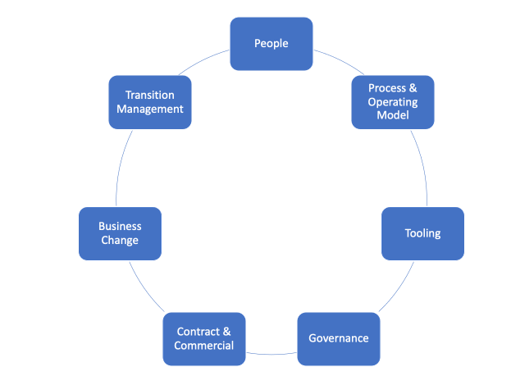
SIAM Programme workstream scope
Below I give a brief explanation of the scope of each of the workstreams.
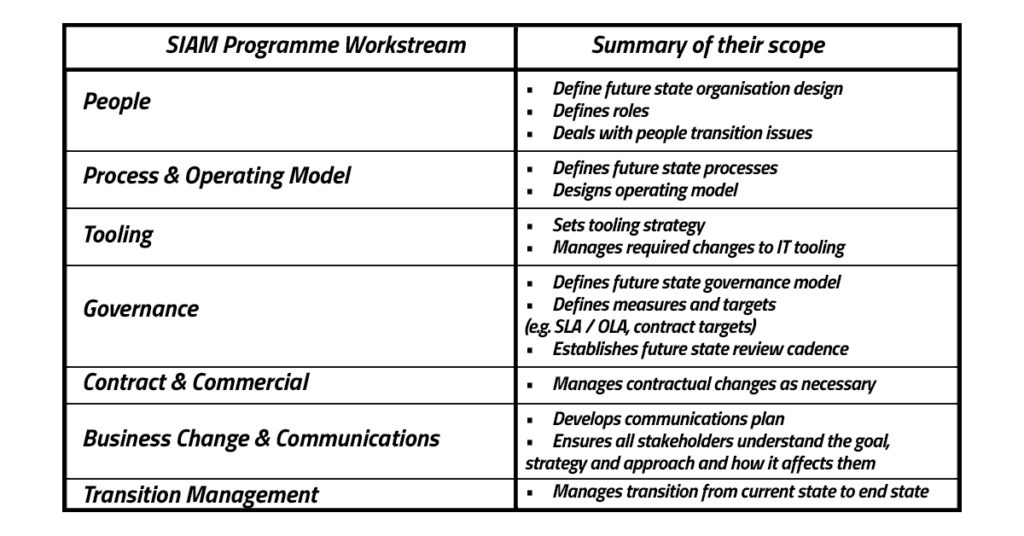
It’s worth emphasising that of all the workstreams above, the most critical to get right is that of Business Change. Failure to acknowledge the need to bring leadership, process practitioners, suppliers and end users along on the journey to change your IT Operating Model, can result in a lack of acceptance and inability to make your change stick.
Conclusion
In summary, moving to a SIAM model isn’t a trivial programme. It will affect the whole of IT, through the entire IT value chain.
Successfully moving to a SIAM model is not just about process. It also encapsulates changes to tooling, governance, organisation design and contracts. But most critical of all is the need to address business change implications, ensuring that those impacted by the change understand what is changing, why it’s changing, when it’s changing and how it will affect them directly.
Conducting a programme of education, communication and buy-in activities will be critical to ensuring that your team are right behind you as the progress through the transition from your current mode of operation to your target operating model.
You can read more of our SIAM content by clicking through to our dedicated SIAM channel on our website.
About the author

Steve Morgan is Director of Syniad IT, a specialist consulting firm, specialising in IT operating model assessment, design and implementation. Steve has extensive experience of running and improving IT organisations, having worked with some of the world’s most complex and challenging companies. Steve has worked on the UK’s most high profile SIAM programmes, and is part of the SIAM author team for many SIAM publications.

